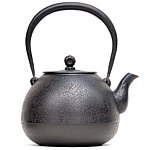It is decorated with a gourd pattern, which is said to bring good luck.
The gourd is said to symbolize 「prosperity of the family」 and 「prosperity of offspring」 because of the way the fruit grows in a row.
The lid knob is designed to resemble gourd.
The inside is finished with a rust-resistant finish using the traditional 「kama-yaki」 technique.
Kamayaki is done by firing the tetsubin in a high-temperature oven.
This process forms an oxide film on the surface of the tetsubin.
The oxide film stabilizes the iron content of the tetsubin.
The flavor of boiled water is improved and rust and corrosion are prevented.
Rust-proofing by kettle firing is a traditional technique that has been handed down since ancient times.
The handle has been twisted to accentuate one point.
The twisted finish improves the ease of holding and fitting in the hand, and enhances the beauty and style of the tetsubin as a whole.
Capacity is about 1.2L.
The appropriate capacity is about 1L.
The handle is fixed.
It can be used with IH.
Do not use on high heat.
Please use below medium heat.
History of Oitomi casting works
Founded in 1848 by Rigenta Oikawa in Haneda-village, Esashi-gun, Iwate Prefecture.
He also served as a foundry master for the The Date Family of Warlords.
Since the Meiji period, manufactured mainly tea kettles and iron kettles.
Oitomi casting works products have been selected for numerous art exhibitions.
Oitomi casting works unique designs and craftsmanship are still highly regarded today.
Manufacturer::Oitomi casting works
Size:W20.5cm x 18.5cm x 18.5cm
Weight::Approximately 2kg
Capacity::Approximately 1.2L
Material:cast iron
Country of manufacture:Japan (Iwate Prefecture)
Packaging form / accessories:Special box, instruction manual
Information on customs duties
Customs duty may be incurred when purchasing Japanese products from overseas.
We will enter a lower price for the item, but please note that the buyer will be responsible for any customs fees incurred.
The gourd is said to symbolize 「prosperity of the family」 and 「prosperity of offspring」 because of the way the fruit grows in a row.
The lid knob is designed to resemble gourd.
The inside is finished with a rust-resistant finish using the traditional 「kama-yaki」 technique.
Kamayaki is done by firing the tetsubin in a high-temperature oven.
This process forms an oxide film on the surface of the tetsubin.
The oxide film stabilizes the iron content of the tetsubin.
The flavor of boiled water is improved and rust and corrosion are prevented.
Rust-proofing by kettle firing is a traditional technique that has been handed down since ancient times.
The handle has been twisted to accentuate one point.
The twisted finish improves the ease of holding and fitting in the hand, and enhances the beauty and style of the tetsubin as a whole.
Capacity is about 1.2L.
The appropriate capacity is about 1L.
The handle is fixed.
It can be used with IH.
Do not use on high heat.
Please use below medium heat.
History of Oitomi casting works
Founded in 1848 by Rigenta Oikawa in Haneda-village, Esashi-gun, Iwate Prefecture.
He also served as a foundry master for the The Date Family of Warlords.
Since the Meiji period, manufactured mainly tea kettles and iron kettles.
Oitomi casting works products have been selected for numerous art exhibitions.
Oitomi casting works unique designs and craftsmanship are still highly regarded today.
Manufacturer::Oitomi casting works
Size:W20.5cm x 18.5cm x 18.5cm
Weight::Approximately 2kg
Capacity::Approximately 1.2L
Material:cast iron
Country of manufacture:Japan (Iwate Prefecture)
Packaging form / accessories:Special box, instruction manual
Information on customs duties
Customs duty may be incurred when purchasing Japanese products from overseas.
We will enter a lower price for the item, but please note that the buyer will be responsible for any customs fees incurred.




